



A patio umbrella is essential in enjoying your outdoor space. By providing overhead protection from natural elements (including the sun, precipitation, and wind), an outdoor umbrella enables you to relax in comfort whether poolside, or in your backyard. Determining the right shade for your outdoor space can prove daunting with the many sizes and styles available. This guide provides everything you need to consider -from size, material, style, and features- to make an informed decision on selecting the best patio umbrella for your space.
A patio umbrella frame is made up of the pole, the ribs (that support the canopy), finial, and several mechanisms which allow it to operate smoothly. These include the lift mechanism, tilt mechanism, hubs, and rotating mechanism (in the case of offset umbrellas). To understand how the frame and mechanisms work together, we’ve included some basic information about each of the system components:
Umbrella poles can be solid, or made up of two pieces. In a two piece pole, the pieces are connected together to form the entire pole and this type of umbrella is the easiest to ship and to store. Single piece poles are stronger and more suited to commercial uses such as restaurants, hotels, and condo pool areas because they stand up to strong winds and wind gusts better.
The umbrella canopy is supported by ribs which are mounted on the pole. There are two kinds of ribs on patio umbrellas. The main ribs outspread from the top hub to the edges of the umbrella canopy. Main ribs are located under the canopy fabric and support the fabric panels. The support ribs are connected to both the runner hub and the main ribs and facilitate the opening and closing motion of the umbrella. The more ribs an umbrella has, the stronger and more stable the umbrella is. The strongest ribs are made from fiberglass (which usually last four to five times longer than ribs made from wood or aluminum).
There are two hubs in most patio umbrellas. The runner hub moves up and down the umbrella pole. The support ribs of the umbrella are fastened to the runner hub and facilitate the opening and closing of the umbrella. There is a top hub to which an umbrella’s main ribs are attached. This top hub does not move while the main ribs rise and fall as the umbrella is opened and closed.
A patio umbrella finial performs two functions. It helps anchor the umbrella canopy to the frame of the umbrella. Finials are also a design element which completes the finished look for the top of the umbrella.
The umbrella canopy adds not only aesthetic value to your outdoor space, but is the material that directly protects you from outdoor elements such as sun, wind, and rain. When it comes to outdoor textiles, each display their own set of benefits:
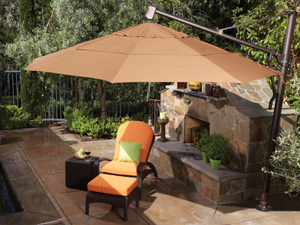
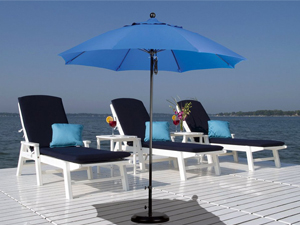
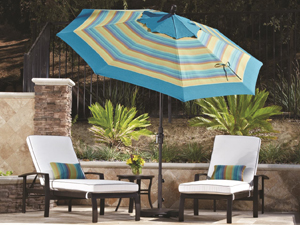

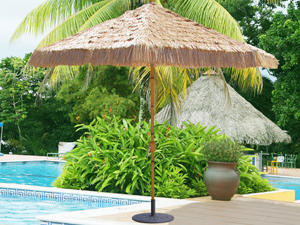
Patio umbrella frames are typically manufactured from wood, fiberglass, and metals such as aluminum and steel. Fiberglass and metal frames usually feature more features than wood frames, while wood frames offer a natural appeal. If selecting a commercial patio umbrella, LuxeDecor recommends selecting an umbrella with the fewest moving parts. The following outlines the benefits of each material:
Material
Qualities

Another important factor to consider when selecting a patio umbrella is the pole height. Take into account the overhead clearance of your outdoor living space, the height of individuals standing upright, as well as, the scale of your outdoor furniture. Overhead shade should sufficiently cover the area directly underneath to comfortably protect indivudals from the sun. Seven feet is the typical minimum pole height of an outdoor umbrella. Look for cantilever and tilting mechanisms to adjust to different sun positions throughout the day.
The term “lift” refers to the method used to open the umbrella canopy. There are 3 basic lift methods:

Push-up is a manual method of opening the umbrella canopy that operates similarly to operating a personal umbrella. The user grabs the hub and manually pushes the canopy up to the desired height, which is locked into place with a pin.
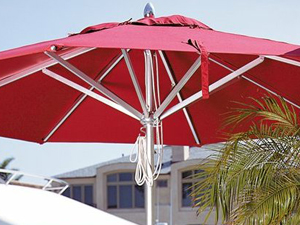
The pulley method uses a rope to assist in raising the umbrella hub with a system of integrated cords that work to expand and open the umbrella canopy. The open shade is typically held in place with a pin.
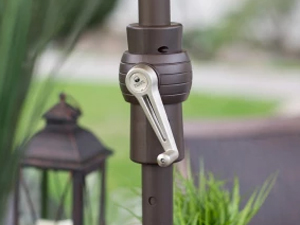
A crank is a handle (usually placed at the center of the pole) that works by turning a crank until the canopy is fully opened.
Umbrellas may feature canopy shades that can be tilted to accommodate the different positions of the sun at different times of the day. A tilting mechanism enables more sun-blocking capabilities. Tilting umbrellas are only available with a crank lift system. There are 3 styles of tilt:
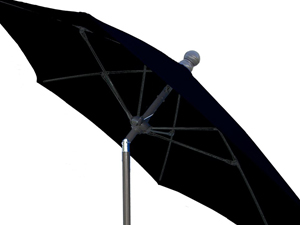
A button allows you to tilt the canopy shade in 2 positions.
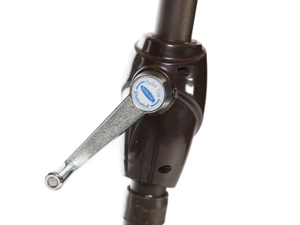
The same crank mechanism used to lift the umbrella canopy can also be utilized to pivot the canopy in different directions.
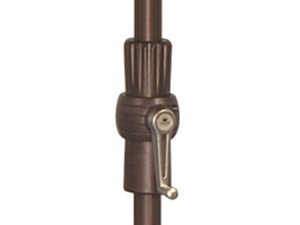
A collar, or ring, located around the hub of the umbrella can be twisted and rotated in order to tilt the canopy in different directions.
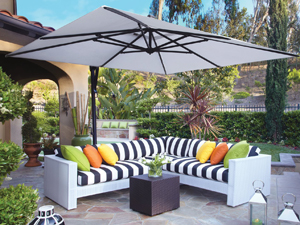
Cantilever umbrellas (also known as offset umbrellas) feature the pole off to one side rather than in the center. This versatile shade solution works well over many seating areas, where a center pole would be an obstruction.Cantilever umbrellas are typically offered in larger sizes, falling within the 9-foot to 13-foot range, but can be available in smaller sizes.
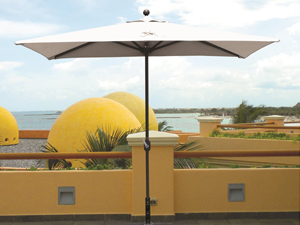
Perfect for small spaces and hard-to-shade spaces such as balconies and porches, a half umbrella features a half-canopy design that can be positioned flush against a wall for the perfect shade solution for confined settings.

A market umbrella is the most popular and common style of patio umbrella which features a clean edge canopy design with seven or eight points of ribs.

The typical beach style umbrella features hanging flaps around the edge.

Similar to the beach umbrella, the drape style features a squared-off edge with hanging flaps off the edge of each side.
An umbrella cover protects the umbrella when not in use. When storing your umbrella, an umbrella cover helps to keep the umbrella dust-free.
Adding lights to your umbrella enables you to enjoy the outdoors well after the sun sets. Some patio umbrellas incorporate integrated lights into the ribs. Another option is a light attachment that is usually battery-operated that can be added to an umbrella.
After wear and tear, umbrellas may need replacement parts to keep it functioning as new. Replacement parts include a new umbrella stand, pole, or canopy.



